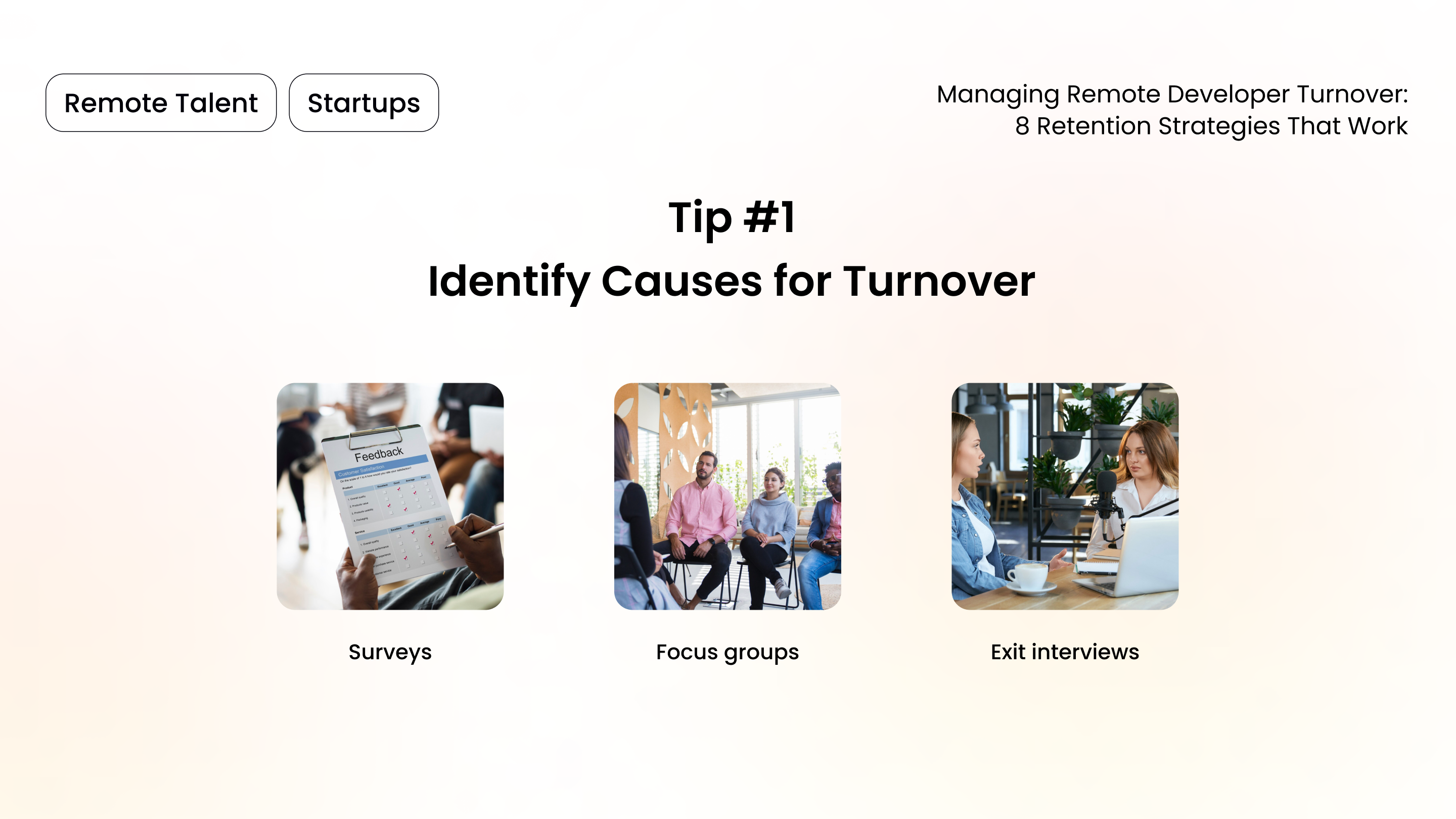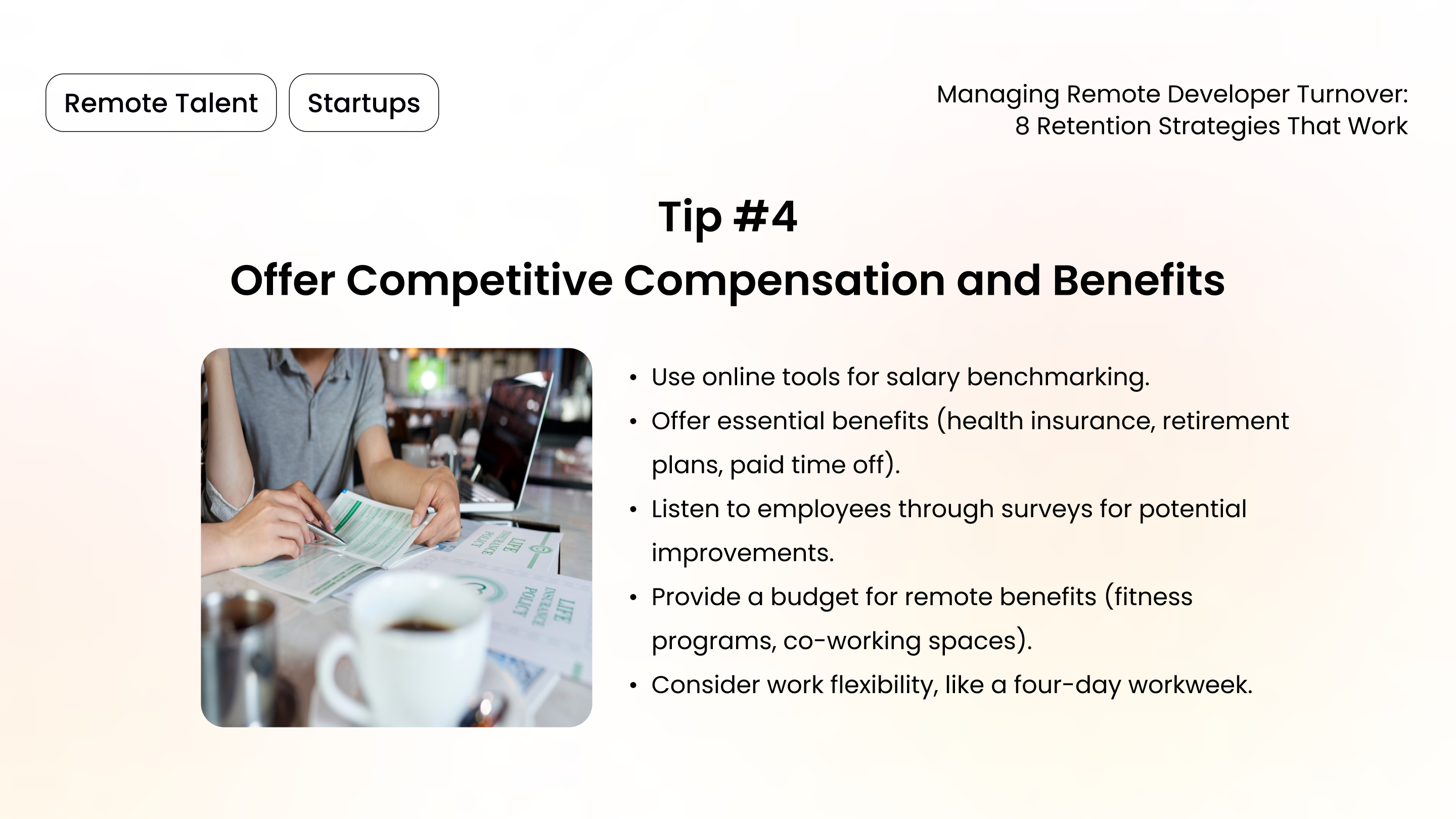Are you struggling to retain remote employees in the world of back-to-back Zoom meetings and endless Slack messages?
You’re not alone! LinkedIn’s Workplace Learning Report showed that 90% of companies are concerned about employee retention. Even the best companies may struggle to keep their remote employees engaged to retain top talents.
Along the fundamental shift to remote working culture, companies leaders and Human Resources managers expected to see improvement in overall retention rates. But it turns out that employee retention rates problem is more complex than it first seemed.
Particularly, tech companies are witnessing high turnover rates among remote developers, which can cause significant disruptions to project timelines, negatively impact team morale, and lead to costly rehiring processes.
In fact, navigating the complexities of remote employee retention doesn’t have to be overwhelming. In this article, we’ll share proven strategies that can help you retain your best talents and foster a remote-first culture. By implementing these strategies, your company can thrive in this new normal, enabling you to work seamlessly across borders and maintain a committed and satisfied remote workforce.
7 Tips for Retaining Your Remote Developer Team
Tip #1: Identify Causes for Turnover
Before addressing turnover, it’s essential to understand its root causes. According to a 2021 State of Remote Work report by Buffer, common challenges include difficulties in unplugging after work (27%), collaboration issues (16%), feelings of loneliness (16%), distractions at home (15%), and lack of motivation (12%). Therefore, it is important to engage directly with your team to understand their challenges and gather comprehensive insights.

There are multiple ways to listen to your employees:
- Surveys: Gather quantitative & qualitative data on work environment, workload, etc.
- Focus groups: Discuss specific issues in depth.
- Exit interviews: Understand why departing employees are leaving.
This multi-pronged approach will help you uncover the root causes of turnover in your organization.
Tip #2: Foster a Remote-First Company Culture
Building a strong company culture is crucial for remote teams, especially when navigating the challenges of constant Zoom calls and never-ending Slack messages. Here are some enhanced strategies to bolster team cohesion and tackle remote employee retention effectively:
- Cultivate a remote-first culture by scheduling routine check-ins and one-on-ones to stay connected with your team and understand their challenges.
- Establish transparent workflows and make decisions as a team, ensuring everyone, regardless of location, feels included and valued.
- Organize virtual hangouts like team lunches or quiz nights to foster a sense of community.
- Prioritize clear, consistent communication and offer growth through online training, mentorship programs, and support for conference participation.
- Be mindful of time zones when planning meetings and deadlines to respect employees’ work-life balance.
- Encourage autonomy and trust, and provide fair and competitive remote salaries to retain top talent.
By integrating these practices, you can create a strong, inclusive work culture that not only enhances team cohesion but also addresses the concerns of remote employee retention head-on.
Tip #3: Empower Managers to Manage People, Not Workload
Managing a remote team requires a unique set of skills focused on people management rather than just task supervision. Remote work dynamics demand an emphasis on team members’ emotional and professional well-being, differing notably from traditional office environments. Training for managers should highlight coaching techniques and support for remote settings, enabling them to boost team development and motivation from a distance.
Routine check-ins are crucial for maintaining open communication, allowing managers to address issues like work-life balance or technological challenges promptly. These sessions also provide valuable feedback on management practices, facilitating adjustments to better support remote employees.
Ultimately, successful remote team management depends on fostering a positive work culture through emotional intelligence, effective communication, and adaptable leadership. This focus ensures remote teams remain productive, engaged, and motivated.
Tip #4: Offer Competitive Compensation and Benefits
To retain top talent in the remote work landscape, ensure your compensation packages are competitive and meet the unique needs of remote employees, including benefits like equipment stipends or co-working space allowances. The global nature of remote work means employees can be targeted by recruiters worldwide, so packages should offer value beyond salary.

Remote work allows access to a global talent pool but requires navigating compensation fairness across geographies and maintaining engagement. To stay competitive:
- Use online tools (Glassdoor, PayScale, etc.) for salary benchmarking.
- Offer essential benefits (health insurance, retirement plans, paid time off).
- Listen to employees through surveys for potential improvements.
- Provide a budget for remote benefits (fitness programs, coworking spaces).
- Consider work flexibility, like a four-day workweek.
In summary, competitive and comprehensive compensation packages that cater to both financial and lifestyle needs are key to attracting and retaining top remote talent, making your company a desirable workplace globally.
Tip #5: Prioritize Remote Employee Wellness and Work-Life Balance
Globally, a significant percentage of employees are now seeking positions that offer better work-life balance and personal well-being enhancement. Surveys indicate that maintaining a harmonious balance between professional and personal life is exceptionally critical in remote work settings.
Remote work, despite its flexibility, can often lead to employee burnout. Here are strategies to support your employees’ mental health and ensure a respectful work-life balance:

- Encourage Regular Breaks: Small breaks can significantly reduce stress levels, improving overall productivity and focus.
- Offer Wellness App Subscriptions: Access to mindfulness or fitness apps encourages employees to take necessary me-time, boosting their daily performance.
- Respect Personal Time: Avoid contacting employees outside of their working hours. If you must send an email after hours, do not expect an immediate response, considering the differences in time zones.
- Implement Meeting-Free Days: Reducing the number of meetings can help combat Zoom fatigue and prevent burnout, promoting a healthier work environment.
By emphasizing employee well-being, companies can foster a supportive and balanced workplace culture that encourages remote employees to remain committed to their roles, thereby enhancing retention and overall satisfaction.
Tip #6: Use data to boost remote employee engagement
In the realm of remote work, leveraging data can significantly elevate your team’s engagement levels. Instead of relying on intuition, solid metrics such as employee satisfaction rates and the employee net promoter score (eNPS) provide a clear, quantitative measure of how engaged and satisfied your team truly is. These indicators can be potent tools in understanding the dynamics of your remote workforce and making informed decisions to enhance their work experience.
Additionally, watch other vital indicators such as employee turnover and retention rates, absenteeism levels, and performance metrics as well. These will offer deeper insights into whether your employees feel valued and if they’re motivated to stay with the company. High turnover might signal underlying issues such as lack of engagement or job dissatisfaction, while frequent absenteeism could be a red flag for burnout or disengagement.
By conducting regular surveys and actively seeking out employee feedback, you can tap into a wealth of actionable insights to ensure your organization not only attracts but also retains happy, engaged employees willing to grow with the company.
Tip #7: Put Trust and Autonomy as The Core of Remote Work
Trust is the cornerstone of remote work, crucial for empowering team members to manage their own tasks without constant supervision. A significant 42% of employees believe their productivity is at risk if their employer doesn’t trust them. To cultivate trust, it’s essential to set clear objectives and then step back, allowing your team to excel. Your role should focus on support rather than micromanagement. While regular check-ins are beneficial, they should aim to assist and guide rather than monitor every move.
Creating a culture of trust and freedom not only boosts employee morale but also demonstrates to your remote team that you have faith in their abilities. This trust can significantly increase their loyalty and happiness, motivating them to remain with your organization. Encourage autonomy and trust to build a more motivated, productive, and satisfied team.
Tip #8: Offer Career Development Opportunities
To retain a highly motivated and engaged remote team, offering career advancement opportunities is key. LinkedIn’s Global Trend Report 2023 also indicated that companies see 7% higher retention rate at the 3-year mark among employees who learned new skills at their job.
- Here’s how you can help your team members to grow:
- Provide access to online courses, personalized internal trainings and workshops
- Host virtual career fairs and networking events to support internal transitions
- Understand and craft individualized career development plan
- Develop a mentorship program to pair remote employees with experienced mentors
- Offer leadership and soft skills training programs
These strategies not only enhance your team’s capabilities but also play a crucial role in retaining talent by investing in their career development.
The Bottom Line
In conclusion, managing a remote team effectively hinges on understanding and addressing the unique challenges it presents. By implementing the strategies discussed—such as setting clear expectations, leveraging technology for better communication, fostering a culture of trust, and investing in career development opportunities—you can cultivate a motivated, productive, and satisfied remote workforce.
Remember, the key to successful remote team management is continuous effort and adaptation to the evolving needs of your team. Encourage feedback, remain flexible, and always look for innovative ways to support and engage your team members. With these practices in place, you can not only achieve your organizational goals but also build a resilient and dynamic remote work culture that thrives on mutual trust and shared success.






